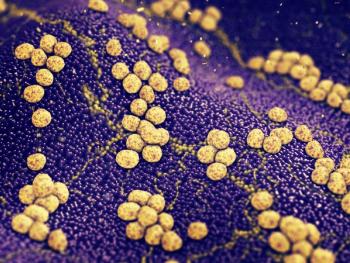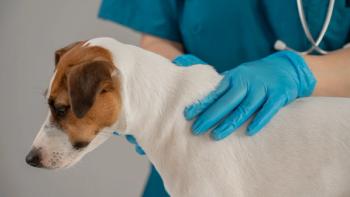
Management of canine allergic dermatitis (Proceedings)
There is no magic injection, pill or salve that is going to cure allergies.
I. What owners need to understand
a. There is no magic injection, pill or salve that is going to cure allergies. They must be managed.
b. Proper management is extremely time consuming
c. Four categories of allergy
i. Food allergy
ii. Atopy
iii. Contact allergy
iv. Insect allergy
a. Allergies are not mutually exclusive
b. Need to exclude and control all secondary causes of pruritus while investigating allergies
i. Yeast dermatitis
ii. Bacterial pyoderma
iii. Scabies
a. Every dog has individual itch threshold
b. Pruritus is additive
c. Controlling one allergy may make others clinically insignificant.
d. Therapeutic goal is to get the pruritus below the dog's itch threshold.
e. First investigate those allergies that cause severe pruritus but are more easily and quickly controlled.
i. Insect (4-8 weeks)
ii. Food (4-16 weeks)
iii. Contact (4-8 weeks)
II. Insect Allergies
a. Must institute strict insect control
b. Fleas
i. Does the pet have fleas?
ii. What do they use for flea control, how often and how do they do it?
iii. Does the pet leave the home environment
iv. Other possible exposure to fleas
c. Flea control
i. On pet
1. Fipronil spray or imidacloprid
a. Use q 7 to 30 days
b. Limit swimming and bathing
ii. Must treat all pets in the house
iii. Environmental control
1. Required
2. Indoors
a. Adulticide
i. Permethrins
ii. Borates
b. Ovicide/ larvicide
i. Borates
ii. Methoprene (Precor®)
iii. Pyriproxifen (Nylar ®)
3. Outdoors
a. Clean up the environment
b. Adulticide
c. Ovicides /Larvicides
i. Pyriproxifen (not degraded by sunlight)
ii. Steinernema carpocapsae (flea nematode)
d. Mosquitoes and Culicoides
i. Access to screen porch
ii. Proximity to water
e. Mosquito / Culicoides Control
i. Most new flea products are not effective as repellents
ii. On pet
1. Permethrins
a. 0.1-0.2% - various products, apply daily
b. Knockout Spray®
iii. 2% permethrin
iv. Dogs only!!!!
v. Use 1-2 times weekly
c. Advantix®
vi. Use every 1-2 weeks if bathing weekly
2. Skin so soft
iii. Environmental control
1. Keep indoors at dawn and dusk
2. Use fine mesh screen ("no-see-um" proof screen)
3. Use propane driven mosquito repellers
iv. Symptomatic treatment
1. Have steroids available
III. Food Allergy
a. Diagnosis
i. Only way is by food trial
1. Should be at least 4 to 16 weeks long
2. Anything can be a food antigen
3. Novel protein and carbohydrate
4. No diet is completely hypoallergenic, including hydrolyzed diets.
5. Homemade diets are still preferable.
ii. Once the pruritus decreases by at least 50% the diet can be challenged.
1. If food allergy is a big part of the problem, significant decrease in pruritus usually takes 3 to 6 weeks.
2. Decrease in pruritus may take up to 16 weeks if food only plays a minor role in the patient's allergies.
3. Challenge diet by feeding old diet or by adding 2-3 tbsp of individual food items to the trial diet for 7-10 days.
IV. Contact Allergy
a. May be more common than you think
b. Look at the environment
i. Carpet deodorizer
ii. Tobacco products
iii. Potpourri
iv. Incense
v. Any aerosolized scents
vi. Highly scented laundry products
vii. Unsealed concrete
viii. Remodeling
ix. Recent changes
x. Landscaping – Wandering jew (Tradescantia fluminensis), Confederate jasmine, Dayflower and Doveweed (Commelinaceae), Dollarweed, and Southern crabgrass are some of the plants we have seen causing contact allergy.
c. Treatment
i. Permanent avoidance
ii. Clothing
1. Jumpers or T-shirts
2. Booties
3. Bodysuits (
iii. Symptomatic therapy
1. Glucocorticoids
a. Topical
b. Systemic
2. Pentoxifylline
a. 10-25 mg /kg q 8-12 hour
V. Atopy
a. Dog is still itchy
i. Secondary causes of pruritus have been treated.
ii. Other primary causes ruled out or controlled.
iii. History and clinical signs are compatible.
iv. Now you can diagnose atopy.
b. Counseling for owner
i. Lifelong disease
ii. Lack of cure
iii. Frequent occurrence of secondary infections
iv. Allergen exposure in dogs is via cutaneous, respiratory and oral routes.
c. Therapy
i. What to take into account
1. Length of season
2. Severity of signs
3. Temperament of patient
4. Temperament of owner
5. Capabilities of owner
ii. Therapeutic plan must be tailored to each individual patient and owner.
iii. Plan should include
1. Control of concurrent infections and allergies
2. Avoidance of allergens if possible
3. Topical and systemic symptomatic therapy
4. Hyposensitization
iv. Length of season
1. Less than 2 to 3 months and mild signs
a. Antihistamines
b. Fatty acids
c. Various topicals
2. Less than 2 to 3 months and severe signs
a. Glucocorticoids
b. Cyclosporine
c. Other systemic drugs
3. Greater than 2 to 3 months
a. All of the above
b. Hyposensitization
v. Antihistamines
1. Not very useful in dogs.
2. Some dogs do respond well.
3. None of the published studies show a dramatic response to antihistamines
4. Most dermatologists do still try antihistamines.
5. Adverse reactions
a. Sedation
b. Dry mouth
c. Hyperexcitability
vi. Fatty acids
1. Most studies do not hold up to statistical scrutiny, except for several studies using omega-3 fatty acids
2. Omega-3 at 180 to 220 mg of EPA/10lb daily
3. Need a 30 day trial to determine if effective
4. May have a synergistic effect with antihistamines or steroids
vii. Topical therapy
1. Helps decrease percutaneous and oral absorption of allergens
2. May decrease the need for systemic therapies.
3. Disadvantages are expense and time commitment.
4. Wipe pet down each time the pet comes inside with baby wipes.
5. Bathe once to twice weekly with antimicrobial shampoo.
6. Antipruritics
a. Use leave on products
b. Topical anesthetics
i. Pramoxine
c. Oatmeal
d. Steroids
i. Hydrocortisone
ii. Triamcinolone
iii. Betamethasone
iv. Fluocinolone
e. Tacrolimus
i. 100 times more potent than cyclosporine and betamethasone.
ii. Ointment is best (Protopic ointment 0.1%)
viii. Glucocorticoids
1. Best anti-inflammatory
2. Not first line drug therapy
3. Use oral instead of repositol injectable so dosage can be titrated to individual patient needs.
4. Prednisone
a. 0.5 to 1.0 mg/lb daily, then taper
b. Remember daily physiologic steroid production is 0.2-0.3 mg/kg
5. Side effects are common with long term use
a. PU/PD
b. Polyphagia
c. Weakness (muscle atrophy)
d. Tachypnea
e. Increased susceptibility to infections
6. Get to the lowest every other day dose that will control the signs and minimize the side effects.
7. Other preparations
a. Methylprednisolone ( 4mg = 5mg of prednisone)
b. Dexamethasone (1/5 to 1/10 prednisone dose)
c. Triamcinolone (1/5 to 1/10 prednisone dose)
d. In some cases these are more effective and have fewer side effects.
ix. Cyclosporine
1. 5 mg/kg q24 hour for 4 to 6 weeks
a. Helps about 75% of dogs at the daily dose
2. At this point try to decrease to q48 hr, then if still doing well, then down to twice weekly.
a. Only about 30 to 50% of dogs can get to the lower dose
3. Good alterative to corticosteroids, especially in dogs who do not handle steroids well.
4. Not a first line drug
5. May be cost prohibitive
a. Ketoconazole (5 mg/kg daily) can reduce the cost by reducing the cyclosporine dose by up to 60%.
6. Side effects
a. Hepatoxicity and nephrotoxicity are not seen in dogs and cats (seen in humans)
b. Vomiting and diarrhea are the most common side effect.
c. Papillomas
d. Hirsutism
e. Secondary infections
f. Long term effects are still not completely known
x. Other systemic drugs
1. Misoprostil (PGE1 analog)
a. Small study showed significant improvement
b. Very expensive
2. Pentoxifylline
a. 10 mg/kg q12 hour
b. Small study showed significant decrease in erythema and pruritus.
3. Zileuton (5-lipoxygenase inhibitor)
a. Little evidence of positive effect
4. Zemaphyte (Chinese herbal medicine)
a. May have some benefit
xi. Allergy Testing
1. Only reason to allergy test is to select allergens for hyposensitization or for avoidance of indoor allergens
2. Allergy testing is a therapeutic tool, not a diagnostic one.
3. Intradermal testing
a. Still the gold standard
b. Need some expertise to perform
4. Serum allergy testing
a. No regulation of laboratories doing these tests
b. Many are still plagued by false positives
i. Impact of these false positives can be minimized by careful patient selection.
c. Many also are plagued by false negatives
i. We have patients with very positive IDSTs whose serum tests came back completely negative.
d. When you decide to allergy test and what you do with the results are as important as which test you use.
xii. Avoidance
1. House dust mite
a. Environmental control appears more effective than hyposensitization.
b. Control
i. Freeze or get rid of stuffed animals
ii. Get rid of old dog beds
iii. Do not allow the pet under furniture
iv. Do not vacuum with pet in room
v. Cover bedding with plastic
vi. Change air conditioner filters monthly
vii. Use anti-allergy sprays
viii. Use miticides on carpets
2. Molds
a. Find out about water damage etc.
b. Repair and replace the mold damaged material.
xiii. Hyposensitization
1. Therapy of choice for long term management of pollen allergies
2. Control, not a cure
3. It is an injection
4. No known long term side effects
5. Acute side effects
a. Increased pruritus
b. Slight chance of anaphylaxis and death
6. Success rate
a. 75 to 80% of the cases improve
i. ⅓ are excellent
ii. ⅓ are good
iii. ⅓ you aren't sure it but they are worse if you stop
b. Depends greatly on who manages the case
c. Varies with
i. Age of the patient
ii. Number of allergens
1. Dogs with more than 21 positives have poorer responses.
2. These cases may need 2 different allergy vaccines
iii. Sensitivity of the patient
iv. Breed of dog
d. Clinical response can take up to 18 months
i. Do not expect much change for the first 3 to 4 months.
e. Must continue symptomatic therapy at first
f. There are no standard injection schedules.
i. Schedules must be varied depending on the response of the patient.
ii. Concentration, frequency or amount of vaccine may be varied depending on patient's response.
g. Some patients can stop after 2 to 3 years but life long therapy is recommended.
i. Many dogs may start showing signs again after a time and they do not always respond as well to hyposensitization the second time around.
VI. Conclusions
a. Look for and treat secondary infections.
b. Look for and control all other types of allergy.
c. There is no standard therapeutic plan.
d. Each plan is additive and must be tailored to the individual patient and owner.
Newsletter
From exam room tips to practice management insights, get trusted veterinary news delivered straight to your inbox—subscribe to dvm360.




